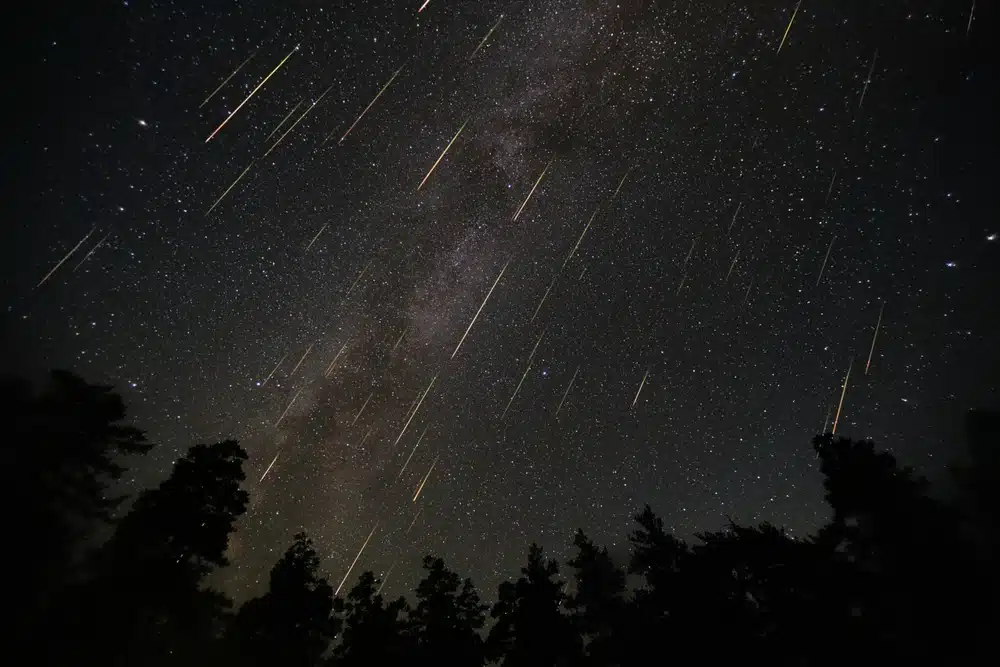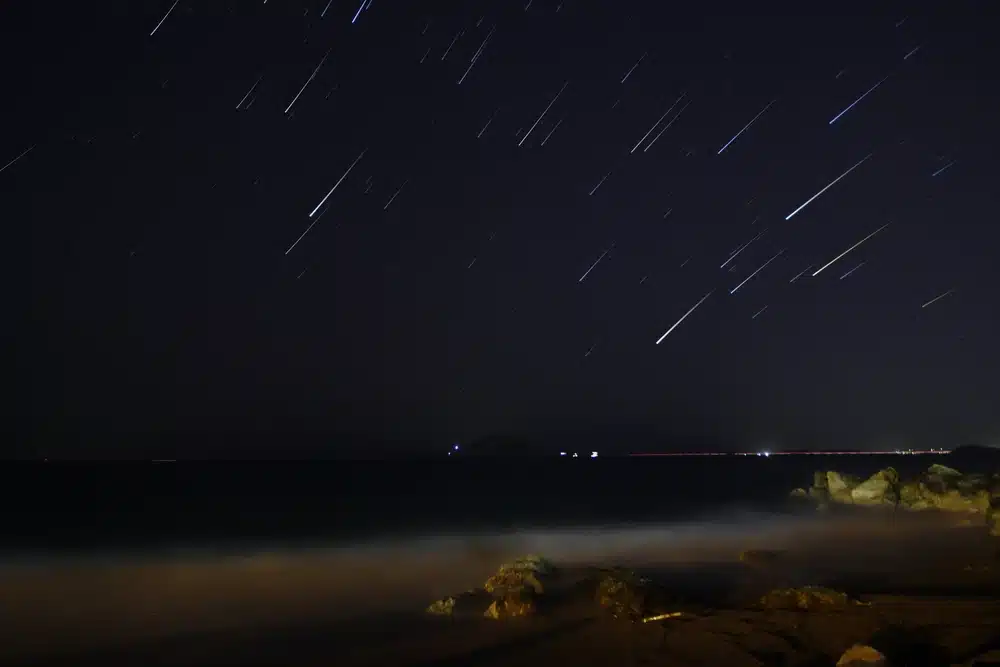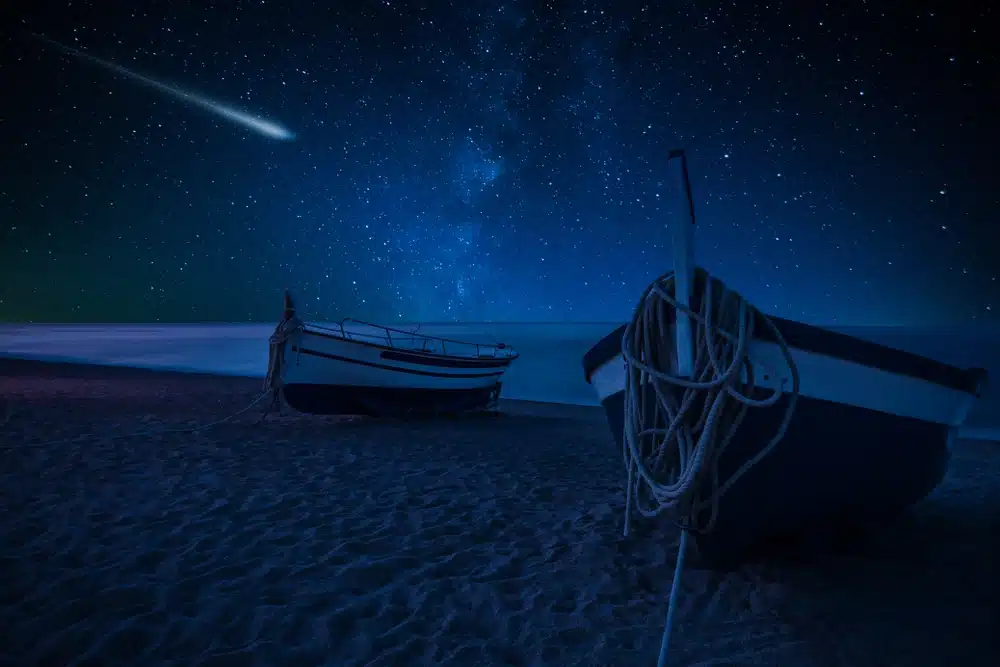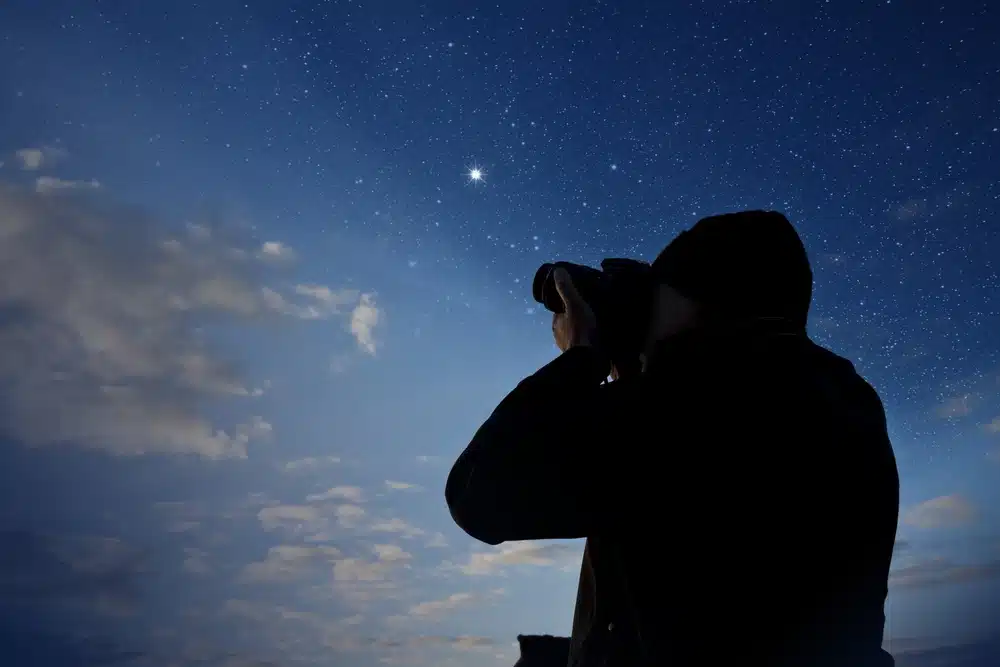Cuprins
Every year, the summer sky offers us a fascinating spectacle: the Perseid meteor shower. This astronomical wonder, also visible from Romania, attracts enthusiasts and amateurs alike. But what are the Perseids and how do they form? We invite you to discover the secrets, find out where you can see them in Romania and how to prepare for a magical night under the stars.
- What are Perseids and how they form
- When and where to observe the Perseids in Romania
- Perseid Night – how to prepare for the celestial show
- Danube Delta – the perfect destination for Perseids watching
- How to photograph the Perseids and shooting stars
What are Perseids and how they form
Perseids are a special annual astronomical phenomenon, commonly called a star shower. It happens in summer, with peak activity around August 12.
This is created by fine particles of cosmic dust left by comet 109P/Swift-Tuttle.
When the Earth passes through this comet’s orbit, these particles enter the Earth’s atmosphere at a considerable speed of about 57 km/s, creating the shooting stars we see in the sky.

Cometa Swift-Tuttle, origin of the Perseids
Perseid formation starts with the release of dust and ice particles by comet Swift-Tuttle as it approaches the Sun. These particles form a cloud of cosmic debris along the comet’s orbit. Every year, the Earth passes through this cloud, and as the particles enter the atmosphere, they ignite due to friction with the air, ionizing it and producing the characteristic light trails.
An interesting aspect of the Perseids is that they appear to radiate from a fixed point in the sky, called a radiant, in the constellation Perseus. This optical illusion is a perspective effect, similar to the convergence of railroad tracks in the distance.
When and where to see the Perseids in Romania
In Romania, the Perseids are visible between July 17 and August 26, peaking on the night of August 12-13. Under favorable weather conditions, up to 100 meteors per hour can be seen during the peak period.
The best time to see the star showers is after midnight until sunrise, especially between August 11 and 14, when the waxing and waning of the phenomenon can be seen. The night of August 12-13 is considered the peak of the phenomenon.

Perseids seen at their peak
To increase your chances of seeing the Perseids in Romania, choose a place with dark skies, away from city lights. Look for an area with good visibility to the northeast and avoid looking at phone screens or other bright light sources.
The Perseids can be seen with the naked eye without special equipment. For extra comfort, you can use a deckchair or blanket and appropriate clothing, even on summer nights. Patience is important – a watching session of at least an hour increases your chances of seeing meteors.
▶️ If you want to discover the magic of the Perseids at the mouth of the Danube into the Black Sea, we have prepared a series of trips in the Delta, which will give you the opportunity to watch the nightly spectacle of the star shower from the channels of the great river.
Once we know when and where to observe, it’s essential to prepare properly for this unique experience. Here are some tips to make sure you have a magical night.
Perseid night – how to prepare for the celestial show
The Night of the Perseids is an annual astronomical event that attracts many enthusiasts. To fully enjoy the show, choosing the right location and adequate preparation are essential.
Identify a dark place as far away as possible from the artificial light of cities, such as rural, mountainous areas or isolated beaches.
A moonless sky offers better visibility for the Perseids. As mentioned, observing is most favorable after midnight to dawn, especially from August 11-14, peaking on the night of August 12-13.

Perseids seen at the seaside
For a cozy night under the stars, pack a sun lounger or blanket to stretch out on, warm clothes, snacks and water. A flashlight with a red light can be useful, as it doesn’t affect your eyes’ dark adaptation.
To increase your chances of seeing as many Perseids as possible, look at as wide an area of the sky as possible and don’t focus on just one spot. Allow at least an hour to observe.
The Danube Delta – the perfect destination for watching the Perseids
The Danube Delta, one of the most spectacular and well-preserved natural areas in Europe, offers ideal conditions for observing astronomical phenomena, especially the Perseid meteor stream.
Thanks to its remoteness, extremely low light pollution and often clear skies on summer nights, the Delta becomes a true haven for astronomy enthusiasts and those who want a memorable visual experience under the canopy of the sky.

Perseids seen in the Danube Delta
Sfântu Gheorghe Beach is one of the most recommended places to watch the Perseids in the Delta. Situated at the end of one of the three main arms of the Danube, this wild and expansive beach offers an unobstructed view of the night sky. The distance from larger towns and the lack of street lighting make it almost pitch dark, essential for a clear view of meteors streaking through the atmosphere. At the same time, the calm sound of the waves crashing against the shore creates a soothing background sound, harmoniously complementing the night-time visual spectacle.
The place where the Danube flows into the Black Sea, near Sfântu Gheorghe, adds a symbolic and poetic dimension to the experience. This confluence between the river and the sea is a vast, open and peaceful space, where the sky seems closer and the stars more vivid. Watching the Perseids here, in a landscape dominated by water and endless horizons, is an experience that combines natural beauty with the thrill of discovery.
▶️ To make your Perseid watching experience perfect, at Green Dolphin Camping you will find the right place to stay and collect beautiful memories, whether you prefer the privacy of a minimally equipped cottage or connecting with nature in the camping space.
The secluded canals and gullies in the Chilia Veche or Letea area, although more difficult to reach, also offer excellent conditions for amateur astronomers.
The total lack of artificial lighting and the presence of a wild natural habitat give these places a special charm. Sleeping in tents or remote eco-tourist hostels, followed by a night under the open sky, can turn watching the Perseids into a real adventure.
The Letea Forest, known especially for its unique biodiversity, becomes a silent and mysterious space after sunset, where you can gaze at the sky through the rare crowns of ancient trees. Although the vegetation may limit the visibility of the sky in places, the silence and complete seclusion contribute to a mystical atmosphere.
The Danube Delta therefore offers many great places to admire the Perseids. Whether you choose a deserted beach at the edge of the sea, a secluded sandy beach or a quiet canal bank, you’ll be rewarded with one of the clearest and most impressive views of the night sky in Romania.
How to photograph the Perseids and shooting stars
Photographing the Perseids and shooting stars can be a fascinating activity for astronomy and photography enthusiasts.
To capture these spectacular celestial phenomena, you’ll need a DSLR or mirrorless camera with manual settings, a wide-angle, open aperture lens, a stable tripod and a remote control or timer to trigger the camera.

Shooting the Perseids
For shooting shooting shooting stars, we recommend an ISO between 1600 and 3200, the aperture should be as open as possible (f/2.8 or smaller), the exposure time between 15 and 30 seconds, and manual focus should be set to infinity.
In terms of composition, try to include an interesting element in the foreground, orient the frame to the north-east and try to include the Milky Way in the background for a spectacular visual effect.
To get the best results, choose a location away from light pollution, follow the weather forecast to ensure clear skies, and be at the location at least an hour before the start of observations to familiarize yourself with the area.
▶️ You can find out more about night sky observing in the Delta in our article Stargazing in Romania – the complete guide to telescopic observing of the Moon, the Milky Way and eclipses.
Once you’ve finished your photo session, you can enhance your images by adjusting contrast and brightness, reducing photo noise and accentuating the natural colors of the Perseids and the night sky.
Photographing this annual phenomenon takes patience and practice, but the results can be extremely rewarding, giving you the opportunity to capture the fleeting beauty of shooting stars and create memories that will last a lifetime.
The Perseids are a unique opportunity to connect with the universe and admire the ephemeral beauty of shooting stars. Plan your location in advance, equip yourself accordingly and enjoy the celestial show! Whether you choose the mountains or a quiet spot in the Delta, the memories created under the meteor shower will surely be unforgettable.
Photo source: Shutterstock



